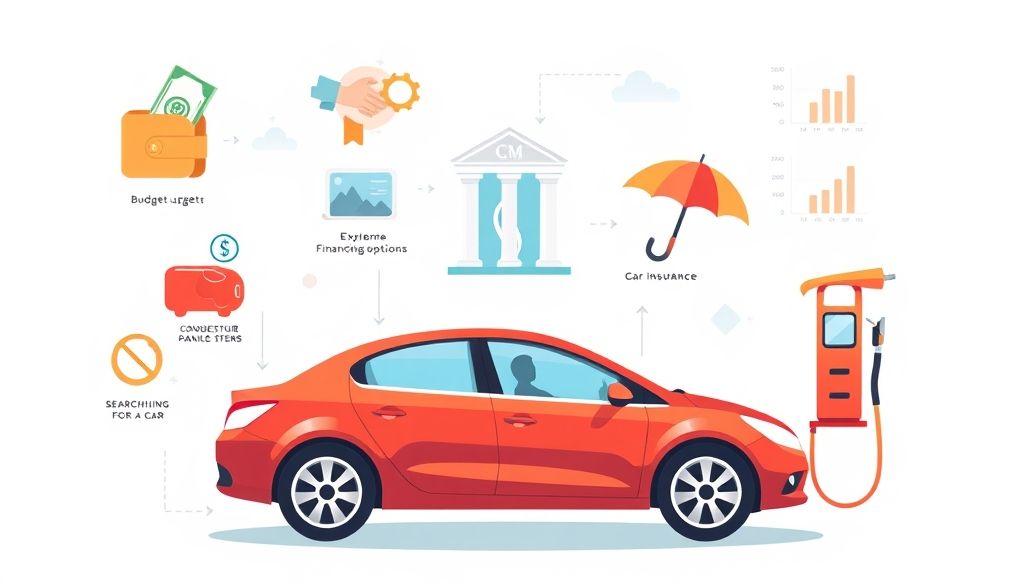Smart Financial Planning for Buying a Car: A Comprehensive Guide
Buying a car, whether new or used, represents a significant financial decision that requires careful planning to ensure it doesn't negatively impact your budget. This article provides you with a comprehensive and detailed guide to help you make this decision wisely, starting from identifying your needs to negotiating the best deal.
Chapter 1: Identifying Needs and Budget
1.1 Defining Basic Needs
Before you start looking for a car, it's essential to define your basic needs. Ask yourself:
- What is the primary purpose of the car? (Daily commute, family trips, business purposes)
- How many passengers do you need to accommodate?
- What features are essential for you? (Navigation system, rearview camera, advanced audio system)
- Do you prefer a fuel-efficient car or one with powerful performance?
1.2 Setting a Suitable Budget
Setting a budget is the most important step. A general rule is that the car's value should not exceed 20% of your total annual income. Consider the following costs:
- Car price (including taxes and fees)
- Insurance costs
- Routine maintenance costs
- Fuel costs
- Annual registration fees
Example: If your annual income is $100,000, the car's value should not exceed $20,000.
Chapter 2: Saving and Accumulating a Down Payment
2.1 Creating a Savings Plan
Start saving early to accumulate a substantial down payment. The larger the down payment, the lower the financing amount required, and consequently, the lower the interest paid.
- Set a realistic down payment goal.
- Create a dedicated savings account for the car.
- Reduce unnecessary expenses.
- Look for additional sources of income.
2.2 Utilizing Savings and Investment Tools
You can utilize savings and investment tools to increase your savings. Some options include:
- High-yield savings accounts.
- Certificates of deposit.
- Low-risk investment funds.
Chapter 3: Exploring Financing Options
3.1 Financing from Banks and Financial Institutions
Banks and financial institutions offer various financing options for buying cars. Compare different financing offers in terms of:
- Annual Percentage Rate (APR)
- Financing term
- Additional fees
- Early repayment terms
Tip: Get pre-approval for financing before you start looking for a car. This will give you a clear idea of how much you can spend.
3.2 Financing from Car Dealerships
Car dealerships also offer their own financing programs. These programs may be attractive due to promotional offers such as zero interest or low monthly payments. However, be sure to read the terms and conditions carefully.
3.3 Other Financing Alternatives
There are other alternatives to traditional financing, such as:
- Islamic financing (Murabaha, Ijarah)
- Personal loans
- Crowdfunding
Chapter 4: Searching for the Right Car
4.1 Online Research
Use specialized websites for selling new and used cars to compare prices and specifications. Some popular websites include:
- Official dealer websites
- Used car selling websites (e.g., Craigslist, eBay Motors)
- Car comparison websites
4.2 Visiting Dealerships
Visit different car dealerships to test drive and learn about the features firsthand. Don't hesitate to ask questions to sales representatives.
4.3 Inspecting a Used Car
If you are considering buying a used car, it is essential to have it thoroughly inspected by a qualified mechanic. This will help you avoid unpleasant surprises after the purchase.
Chapter 5: Negotiating the Price
5.1 Researching the Average Market Price
Before you start negotiating, research the average market price for the car you are interested in. You can use specialized websites or consult car experts.
5.2 Setting a Target Price
Set the price you are willing to pay before you start negotiating. Be prepared to walk away if the seller cannot meet your target price.
5.3 Effective Negotiation Skills
Use effective negotiation skills to get the best deal:
- Be polite but firm.
- Look for flaws in the car (if it is used).
- Compare different offers.
- Don't hesitate to walk away.
Chapter 6: Car Insurance
6.1 Different Types of Insurance
There are different types of car insurance, including:
- Comprehensive insurance
- Third-party insurance
- Personal accident insurance
6.2 Comparing Insurance Offers
Compare different insurance offers in terms of:
- Insurance coverage
- Deductible amount
- Additional fees
6.3 Getting the Best Insurance Rate
To get the best insurance rate, you can:
- Compare offers from different insurance companies.
- Increase the deductible amount.
- Get discounts (such as a safe driving discount).
Chapter 7: Completing the Purchase Process
7.1 Reading the Contract Carefully
Before signing the contract, read it carefully and make sure you understand all the terms and conditions. If anything is unclear, ask the seller to clarify it.
7.2 Ensuring All Required Documents are Completed
Make sure all required documents for transferring car ownership and registration are completed.
7.3 Payment and Car Collection
After ensuring that all procedures are completed, make the payment and collect the car.
Chapter 8: Operating and Maintenance Costs
8.1 Fuel Costs
Fuel costs are among the most significant operating costs. Choose a fuel-efficient car to reduce these costs.
8.2 Routine Maintenance Costs
Perform routine maintenance on the car regularly to keep it in good condition and avoid costly breakdowns.
8.3 Repair Costs
Consider potential repair costs. It may be helpful to purchase an extended warranty to cover some of these costs.
Chapter 9: Tips for Reducing Costs
9.1 Driving Economically
Driving economically (such as avoiding sudden acceleration and hard braking) can reduce fuel consumption.
9.2 Regular Routine Maintenance
Regular routine maintenance can extend the life of the car and reduce the likelihood of costly breakdowns.
9.3 Comparing Spare Parts Prices
Compare the prices of different spare parts before buying them.
Chapter 10: Alternatives to Car Ownership
10.1 Long-Term Leasing
Long-term leasing can be a good option if you don't want to bear the responsibility of car maintenance or selling it.
10.2 Car Sharing Services
Car sharing services provide a flexible and economical alternative to car ownership.
10.3 Using Public Transportation
Using public transportation can save money and reduce traffic congestion.
Disclaimer: This article provides general information about financial planning for buying a car. You should consult a qualified financial advisor for personalized advice tailored to your financial situation.




